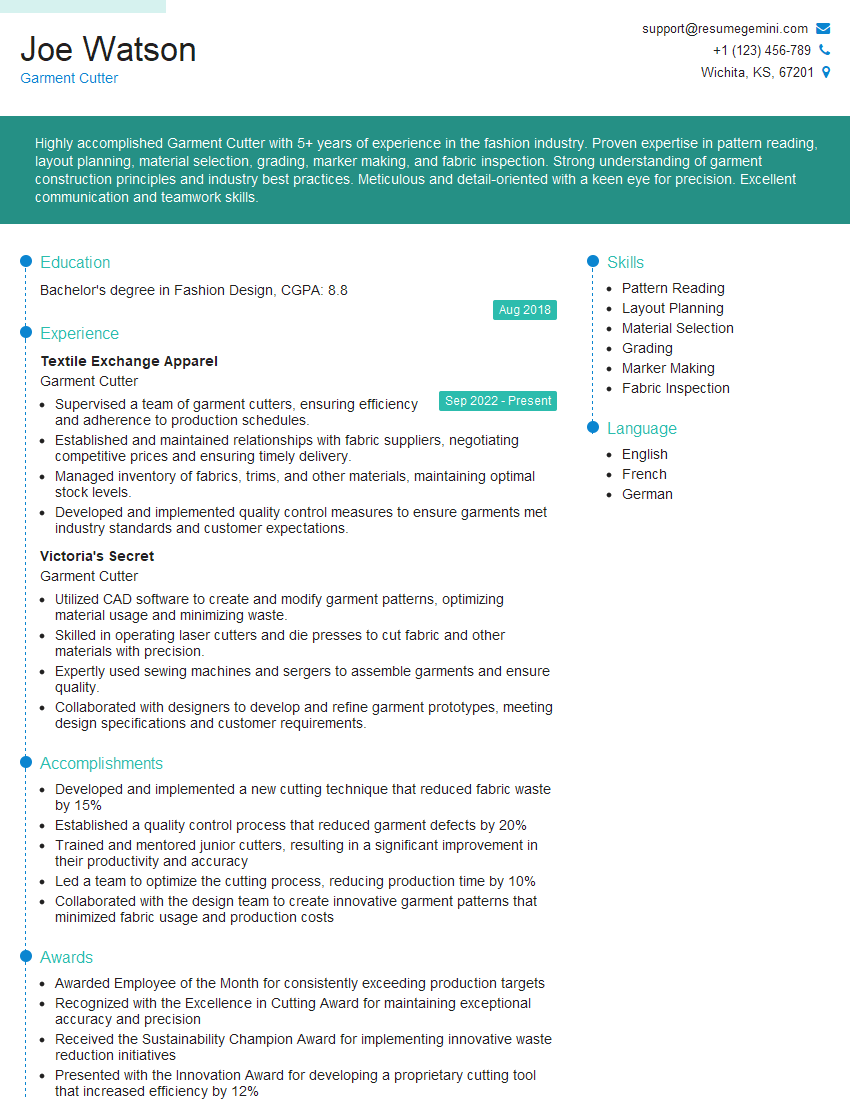Are you a seasoned Garment Cutter seeking a new career path? Discover our professionally built Garment Cutter Resume Template. This time-saving tool provides a solid foundation for your job search. Simply click “Edit Resume” to customize it with your unique experiences and achievements. Customize fonts and colors to match your personal style and increase your chances of landing your dream job. Explore more Resume Templates for additional options.

Joe Watson
Garment Cutter
Summary
Highly accomplished Garment Cutter with 5+ years of experience in the fashion industry. Proven expertise in pattern reading, layout planning, material selection, grading, marker making, and fabric inspection. Strong understanding of garment construction principles and industry best practices. Meticulous and detail-oriented with a keen eye for precision. Excellent communication and teamwork skills.
Education
Bachelor’s degree in Fashion Design
August 2018
Skills
- Pattern Reading
- Layout Planning
- Material Selection
- Grading
- Marker Making
- Fabric Inspection
Work Experience
Garment Cutter
- Supervised a team of garment cutters, ensuring efficiency and adherence to production schedules.
- Established and maintained relationships with fabric suppliers, negotiating competitive prices and ensuring timely delivery.
- Managed inventory of fabrics, trims, and other materials, maintaining optimal stock levels.
- Developed and implemented quality control measures to ensure garments met industry standards and customer expectations.
Garment Cutter
- Utilized CAD software to create and modify garment patterns, optimizing material usage and minimizing waste.
- Skilled in operating laser cutters and die presses to cut fabric and other materials with precision.
- Expertly used sewing machines and sergers to assemble garments and ensure quality.
- Collaborated with designers to develop and refine garment prototypes, meeting design specifications and customer requirements.
Accomplishments
- Developed and implemented a new cutting technique that reduced fabric waste by 15%
- Established a quality control process that reduced garment defects by 20%
- Trained and mentored junior cutters, resulting in a significant improvement in their productivity and accuracy
- Led a team to optimize the cutting process, reducing production time by 10%
- Collaborated with the design team to create innovative garment patterns that minimized fabric usage and production costs
Awards
- Awarded Employee of the Month for consistently exceeding production targets
- Recognized with the Excellence in Cutting Award for maintaining exceptional accuracy and precision
- Received the Sustainability Champion Award for implementing innovative waste reduction initiatives
- Presented with the Innovation Award for developing a proprietary cutting tool that increased efficiency by 12%
Certificates
- Certified Garment Cutter
- Advanced Grading and Pattern Making
- Garment Production Management
- Lean Six Sigma Green Belt
Career Expert Tips:
- Select the ideal resume template to showcase your professional experience effectively.
- Master the art of resume writing to highlight your unique qualifications and achievements.
- Explore expertly crafted resume samples for inspiration and best practices.
- Build your best resume for free this new year with ResumeGemini. Enjoy exclusive discounts on ATS optimized resume templates.
How To Write Resume For Garment Cutter
- Tailor your resume to each job description, highlighting relevant skills and experiences.
- Showcase your technical proficiency in pattern reading, layout planning, and marker making.
- Quantify your accomplishments and provide specific examples of your contributions.
- Proofread your resume carefully for any errors to ensure a professional presentation.
Essential Experience Highlights for a Strong Garment Cutter Resume
- Interpret and analyze garment patterns to determine cut details and fabric requirements.
- Plan and optimize fabric layouts to minimize waste and maximize material utilization.
- Select and prepare materials based on garment specifications, ensuring fabric quality and consistency.
- Grade patterns to create different sizes and adjust for body measurements.
- Create markers using specialized software to guide the cutting process.
- Inspect fabrics for defects and ensure compliance with quality standards.
- Communicate with production teams to ensure timely delivery of cut garments.
Frequently Asked Questions (FAQ’s) For Garment Cutter
What are the key skills required for a Garment Cutter?
Pattern reading, layout planning, material selection, grading, marker making, fabric inspection, attention to detail, precision, and knowledge of garment construction principles are essential skills for a Garment Cutter.
What is the role of a Garment Cutter in the fashion industry?
Garment Cutters play a crucial role in the production process, ensuring the precise cutting of fabric pieces based on design specifications. They determine fabric requirements, optimize layouts, and create markers to guide the cutting process.
What are the different types of fabrics that Garment Cutters work with?
Garment Cutters work with a wide range of fabrics, including natural fibers like cotton, linen, and wool, as well as synthetic fibers such as polyester, nylon, and spandex. They must be familiar with the properties and handling techniques of various fabrics.
What software is commonly used by Garment Cutters?
Garment Cutters often utilize specialized software for pattern grading, marker making, and production planning. Some common software includes Gerber Accumark, Lectra Modaris, and Optitex.
What are the career prospects for Garment Cutters?
Garment Cutters with strong skills and experience can advance to supervisory roles, such as Production Supervisor or Cutting Room Manager. They may also specialize in specific areas, such as pattern grading or marker making.
How can I improve my skills as a Garment Cutter?
To enhance your skills as a Garment Cutter, consider taking courses or workshops on pattern reading, layout planning, and marker making. Additionally, seeking mentorship from experienced professionals and staying updated on industry best practices can contribute to your professional growth.